
The Bottom Line
Introduction, Drive Specifications, Pricing & Availability
When ADATA launched their first NVMe SSD, the XPG SX8000, it was one of the worst performing SSDs on the market. The SX8000 paired Micron first generation 32-Layer MLC flash with SMI's SM2260 NVMe controller. This unfortunate combination conspired to make the SX8000 overpriced and underwhelming on the performance front. True, the SX8000 was one of very few NVMe SSDs that utilized 3D MLC flash, but that contributed nothing to the mix other than driving up production cost.
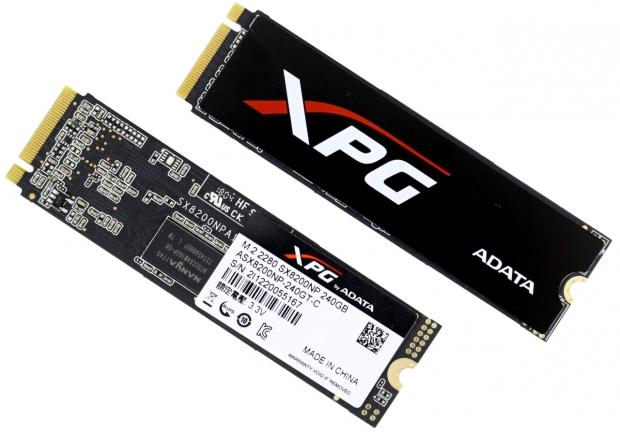
The SX8000, like first generation 3D Micron flash and SMI's SM2260 controller was a learning experience for all involved. Silicon Motion's SM2260 controller is one that we are sure they would rather forget about, but it set the stage for redemption. Same goes for Micron who's first generation 3D NAND was the worst on the market.
Today is a new day - the day of redemption. ADATA's XPG SX8200 is a culmination of doing everything right. ADATA's XGP SX8200 pairs a Silicon Motion SM2262 controller with Micron 64-Layer 3D TLC flash and ADATA's firmware expertise. This time all parties involved brought their A-Game. Micron's second generation 64-Layer 3D TLC flash is the best in the business. SMI's SM2262 controller is one of the industries best, and ADATA's engineering team is on top of their game.
Let's take a quick look at Silicon Motion's potent SM2262 controller:
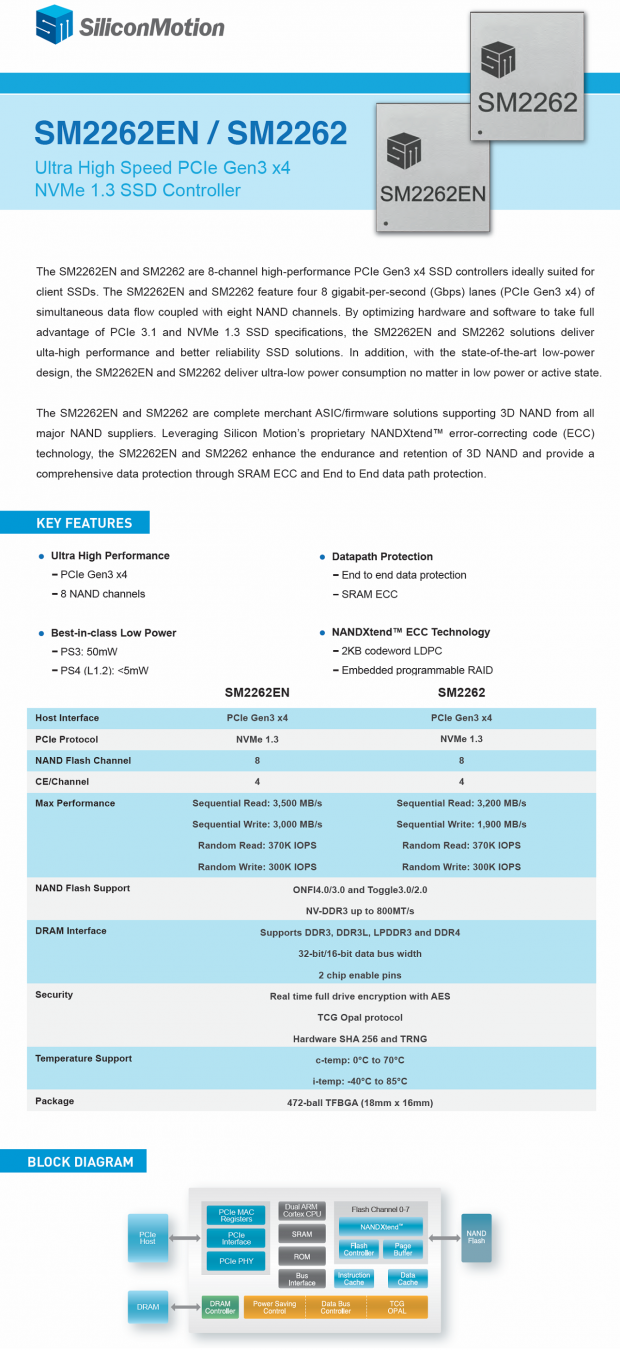
Silicon Motion's SM2262 controller comes in two versions, the SM2262 is the more moderate version and the SM2262EN is the all-out performance version. To date, we have only seen the non-EN version utilized. The SX8200 we have in the lab today utilizes the tamer SM2262 version but make no mistake the SM2262 controller is one of the best available. Both versions deliver similar random performance, but the EN version delivers substantially better sequential performance. Notable features include LDPC error correction (which greatly extends the endurance of NAND-flash), end to end data path protection, encryption, 8 NAND channels, NVMe 1.3 and best-in-class low lower.
ADATA's SX8200 Series pairs SMI's SM2262 controller with Micron's's 64-layer TLC (Triple Level Cell) 256Gbit 3D flash.
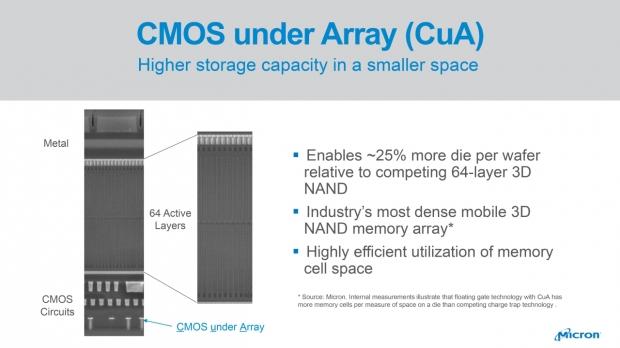
Micron's 64-layer TLC flash is based on floating gate technology with CMOS under array. Micron believes this is more efficient than competitive 3D NAND based on replacement gate technology. Advantages include higher areal density and better manufacturing efficiency, resulting in lower production cost per bit. We will point out that we feel IMFT 64-Layer 3D TLC is the best 3D flash currently on the market. Lowest cost, best random read performance.
Normally we don't spill the beans right off the bat, but ADATA's SX8200 gives us everything we are looking for. Most notable is unmatched low queue-depth random read performance for a flash-based SSD. This is where performance matters, and this is where the SX8200 is better than the rest. Combining performance where it matters most with a 5-Year warranty and a low price-point makes ADATA's SX8200 our current favorite SSD.
Specifications
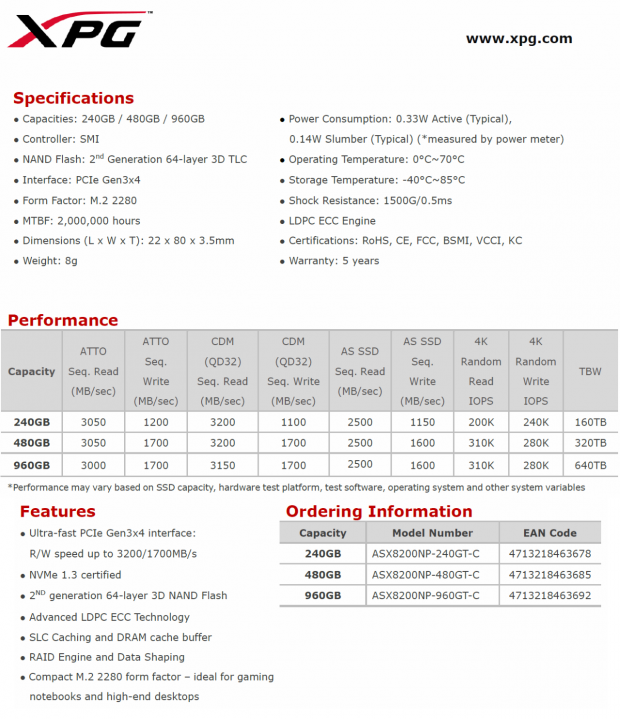
ADATA's XPG SX8200 Series is available in three capacities: 240GB, 480GB and 960GB
- MTBF: 2 Million Hours
- Warranty: 5-Year Limited Warranty
- SLC caching
- LDPC
- Data Shaping
- RAID Engine
- SMART
- TRIM
- Garbage Collection
Availability: The 240GB model is currently selling at Amazon for $99.99, the 480GB model for $189.99.
We will see if we can get a 960GB model in for future testing, which would be great because it is significantly faster than the lower capacity models when running moderate workloads.
Drive Details
ADATA XPG SX8200 M.2 PCIe NVMe SSD
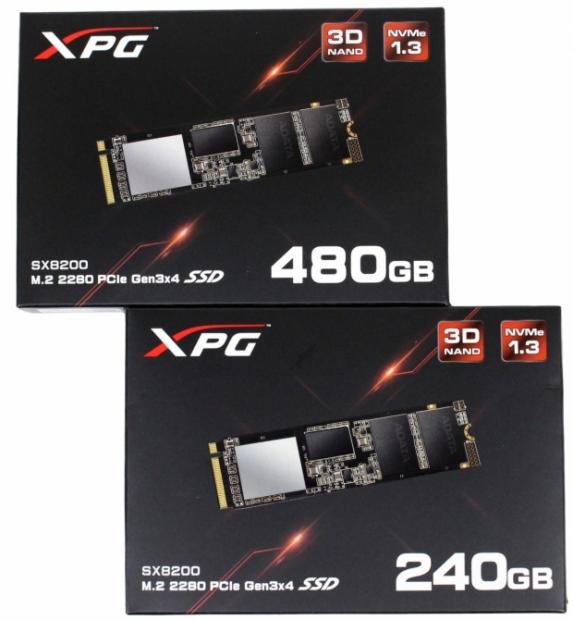
The SX8200 ships in familiar packaging. There is an image of the enclosed SSD on the front. The SX8200's 3D flash, capacity and interface are advertised here.
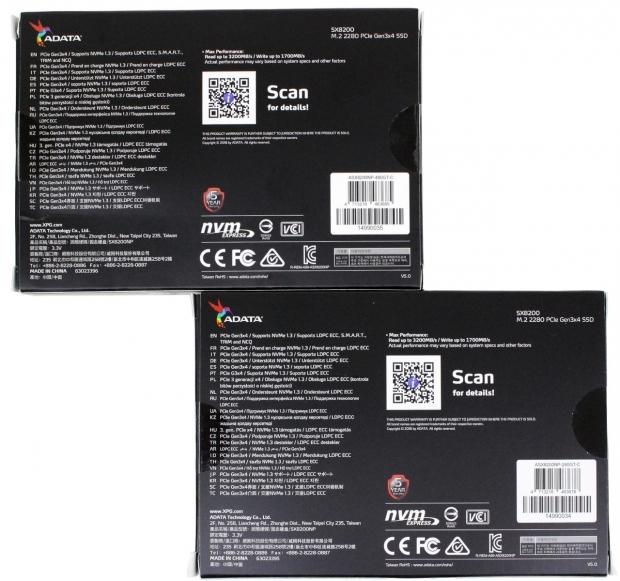
The back of the packaging lists some features and factory performance "up to" sequential specs.
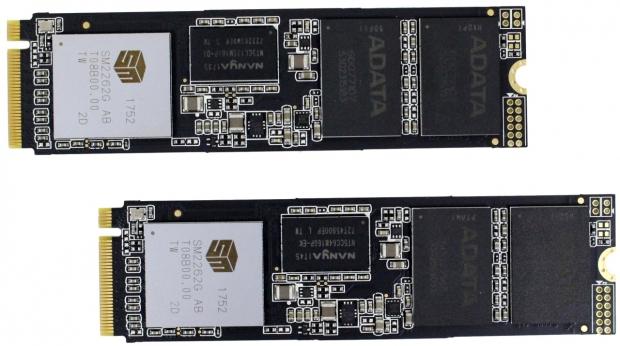
This side of the PCB houses SMI's SM2262 NVMe controller, a Nanya DRAM package and two ADATA labeled Micron flash packages.
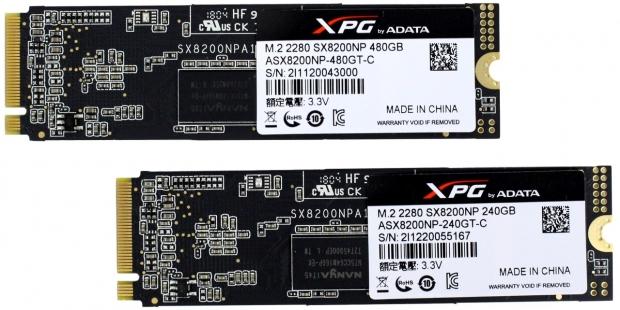
This side of the PCB houses another Nanya DRAM package and two additional flash packages.
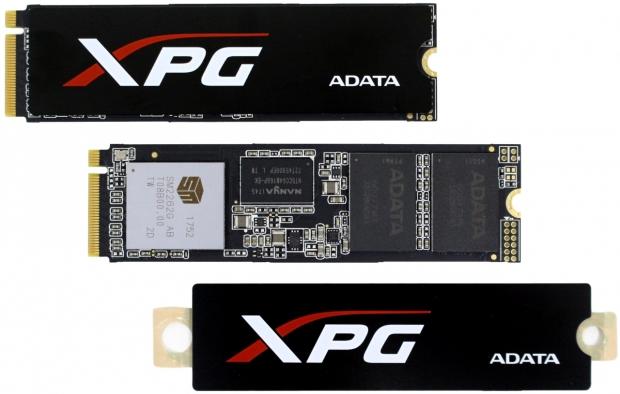
Included with the SX8200 is an optional stick-on metal heat sink. We don't know how effective it is at cooling, but it looks good.
Test System Setup, Drive Properties
Jon's Consumer PCIe SSD Z270 Intel Review Test System Specifications
- Motherboard: ASRock Z270 Taichi - Buy from Amazon / Read our review
- CPU: Intel Core i7 7700K @ 5.0GHz - Buy from Amazon / Read our review
- Cooler: Swiftech H2O-320 Edge - Buy from Amazon / Read our review
- Memory: Corsair Vengeance LPX DDR4 16GB 3200MHz - Buy from Amazon
- Video Card: Onboard Video
- Case: IN WIN X-Frame - Buy from Amazon / Read our review
- Power Supply: Seasonic Platinum 1000 Watt Modular - Buy from Amazon / Read our review
- OS: Microsoft Windows 10 Professional 64-bit - Buy from Amazon
We would like to thank ASRock, Crucial, Intel, Corsair, RamCity, IN WIN, and Seasonic for making our test system possible.
Drive Properties
ADATA XPG SX8200 240GB M.2 PCIe NVMe SSD OS Disk 75% Full
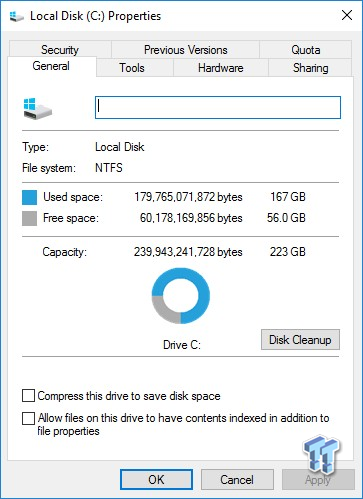
ADATA XPG SX8200 480GB M.2 PCIe NVMe SSD OS Disk 75% Full

The majority of our testing is performed with our test drive as our boot volume. Our boot volume is 75% full for all OS Disk "C" drive testing to replicate a typical consumer OS volume implementation. We feel that most of you will be utilizing your SSDs for your boot volume and that presenting you with results from an OS volume is more relevant than presenting you with empty secondary volume results.
System settings: Cstates and Speed stepping are both disabled in our systems BIOS. Windows High-Performance power plan is enabled. Windows write caching is enabled, and Windows buffer flushing is disabled. We are utilizing Windows 10 Pro 64-bit OS (Build 14393) for all of our testing except for our MOP (Maxed-Out Performance) benchmarks where we switch to Windows Server 2008 R2 64-bit. Empty Windows 10 benchmark screenshots will also be shown on our MOP page.
Please note: When comparing our results to those of other review sites, look at page 10 Maxed Out Performance-Windows 10 which is done with the disk empty.
Benchmark screenshots will be shown 240GB model first followed by the 480GB model.
Synthetic Benchmarks - ATTO & Anvil Storage Utilities
ATTO
Version and / or Patch Used: 3.05
ATTO is a timeless benchmark used to provide manufacturers with data used for marketing storage products. When evaluating ATTO performance we focus on the drive's performance curve and small-file performance.
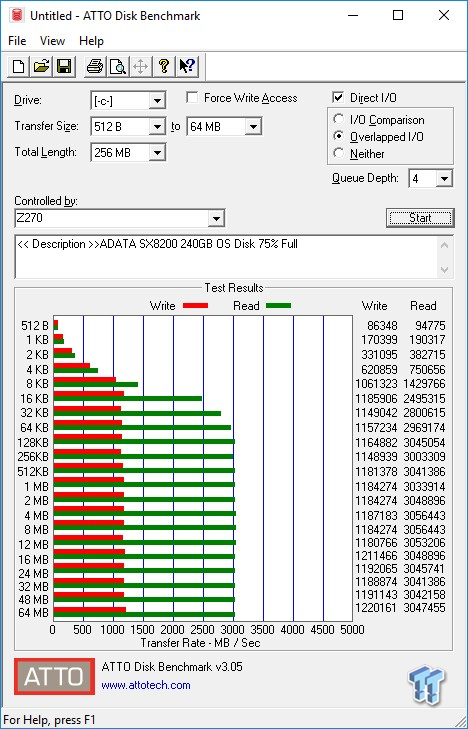
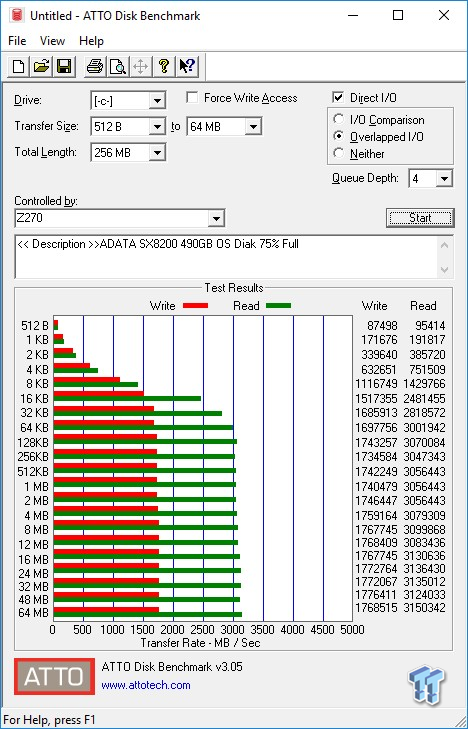
We are able match or exceed factory ATTO sequential read/write performance specs with both capacities even when we are testing as OS volumes 75% full.
Sequential Write

ADATA's SX8200 delivers the best sequential small-file performance for any flash-based SSD we've tested to date.
Sequential Read

The SX8200 delivers to us the best performance curve for a flash-based SSD we've tested to date. This is what we want, and this is what the SX8200 is serving up. This is where we begin to see that ADATA's recipe is a bit better than Intel's 760P which uses the same flash, and controller. ADATA employs double the flash packages and newer firmware, both of which contribute to superior performance albeit at the expense of a single sided design. Lab record.
Anvil Storage Utilities
Version and / or Patch Used: 1.1.0
Anvil's Storage Utilities is a storage benchmark designed to measure the storage performance of SSDs. The Standard Storage Benchmark performs a series of tests; you can run a full test or just the read or write test, or you can run a single test, i.e. 4K QD16. When evaluating performance with Anvils, we focus on total score. When evaluating NVMe SSDs we are typically looking for a minimum total score of over 10K. We place a greater importance on read performance than write performance.
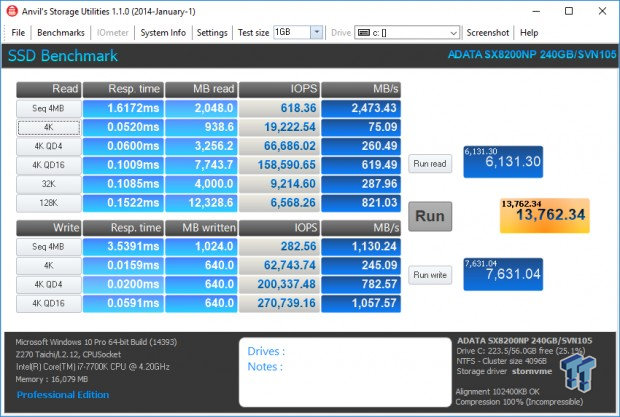
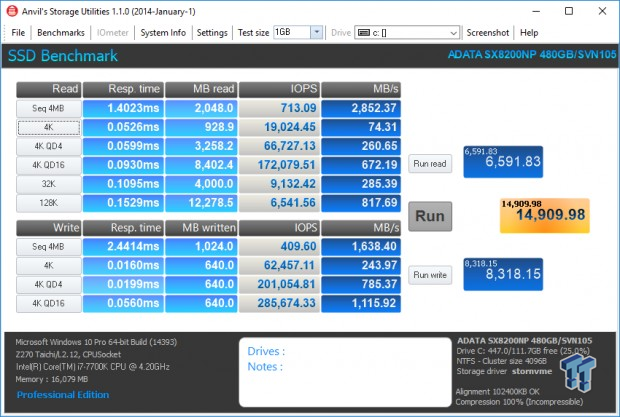
Scoring

In terms of total score, the SX8200 does an admirable job. Now when we dig a bit deeper and look at the all-important read score, the 480GB SX8200 delivers a new lab record for TLC SSDs. This is what we want from an SSD, and testament to why the SX8200 is currently our favorite flash-based SSD.
(Anvil) Read IOPS through Queue Depth Scale
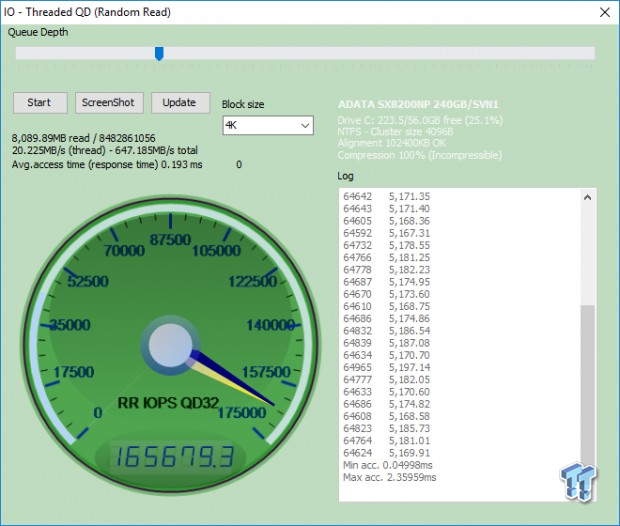
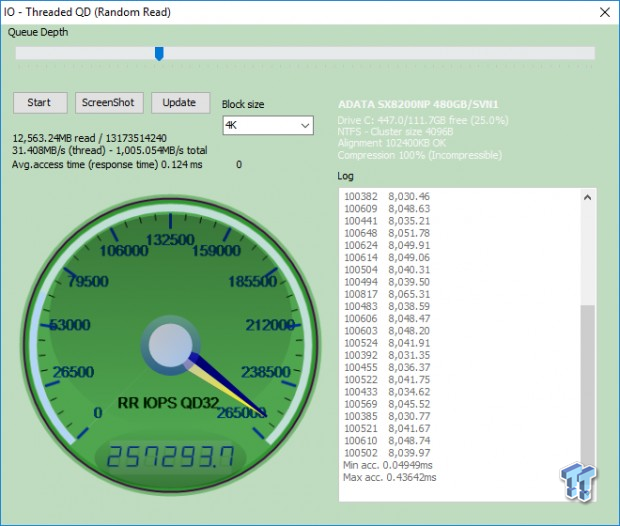
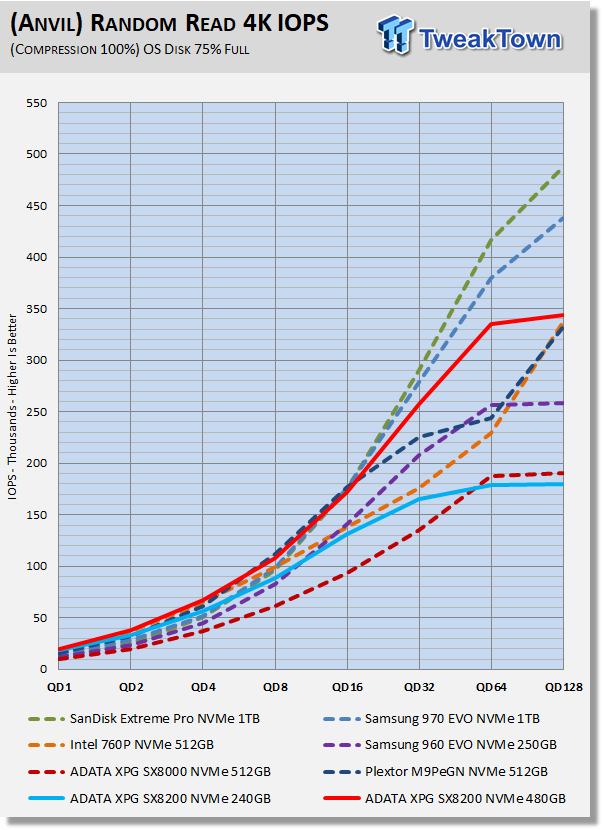
Random performance is much more important than sequential performance for a system disk. Low queue depth random performance is more important than high queue depth performance. Random read performance is more important than random write. With those previous statements in mind, the results of this test are quite impressive. The 480GB model delivers the best QD1-4 random read performance for a flash-based SSD we've ever recorded. Lab record.
(Anvil) Write IOPS through Queue Scale
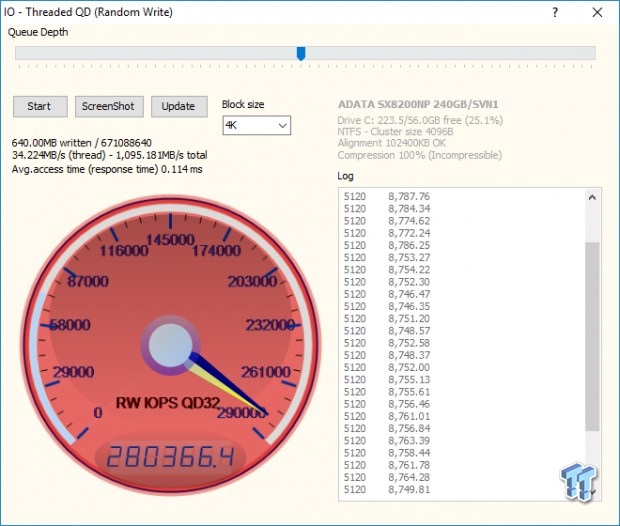
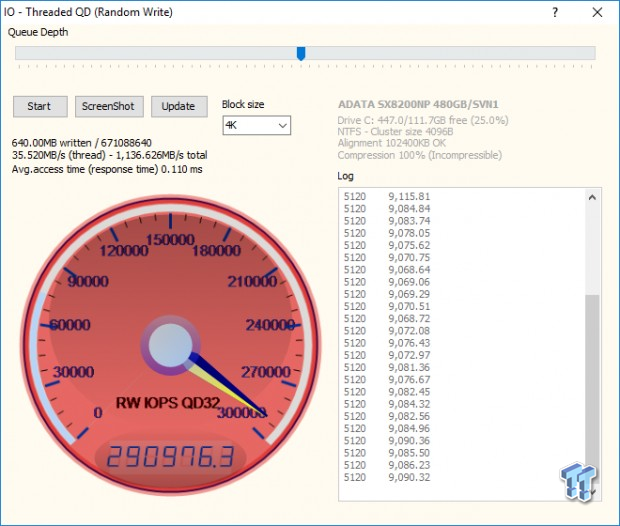
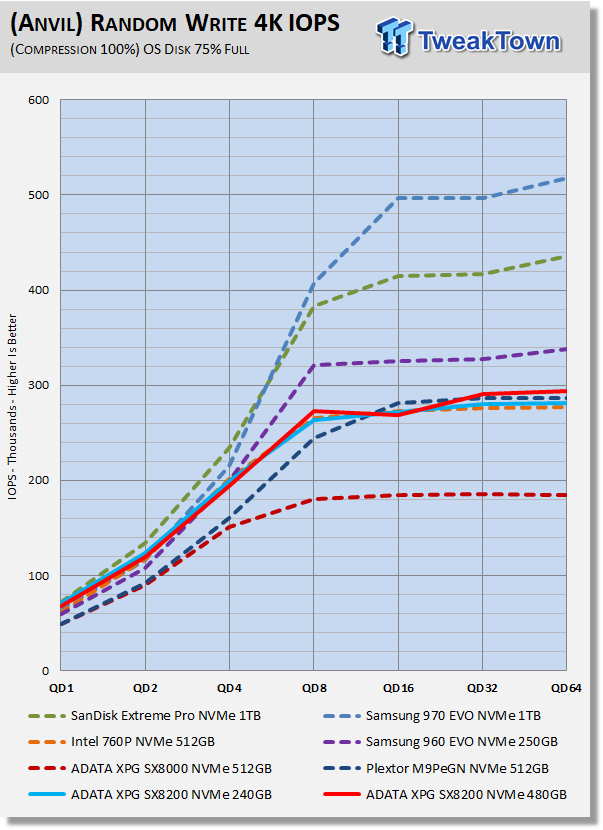
Random write performance at QD1-2 is second only to the write-centric SanDisk Extreme Pro. QD1-2 are by far where random performance matters most and this is where the SX8200 delivers the goods.
Synthetic Benchmarks - CrystalDiskMark & AS SSD
CrystalDiskMark
Version and / or Patch Used: 3.0 Technical Preview
CrystalDiskMark is disk benchmark software that allows us to benchmark 4K and 4K queue depths with accuracy. Note: Crystal Disk Mark 3.0 Technical Preview was used for these tests since it offers the ability to measure native command queuing at QD4. When evaluating CDM results, we focus on 4K random performance at QD1 and QD4.
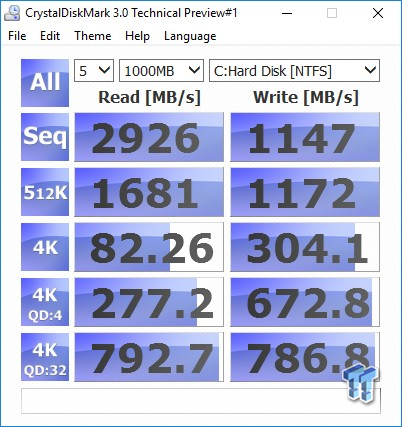
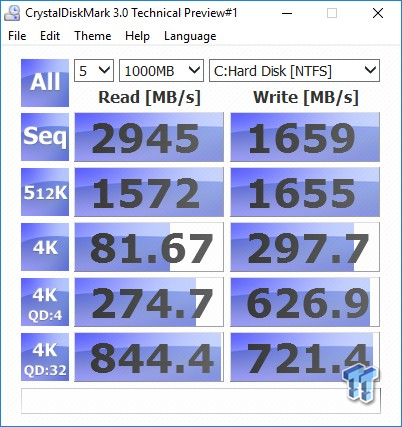

Focusing in on QD1 we find the SX8200 delivering more lab records for flash-based SSDs. At QD4, the 1TB 970 EVO retains the crown, but this may be due to its huge capacity advantage. Our focus with this testing is random, but we will point out that the SX8200 sets another lab record for sequential read performance at QD1. One benchmark, two lab records.
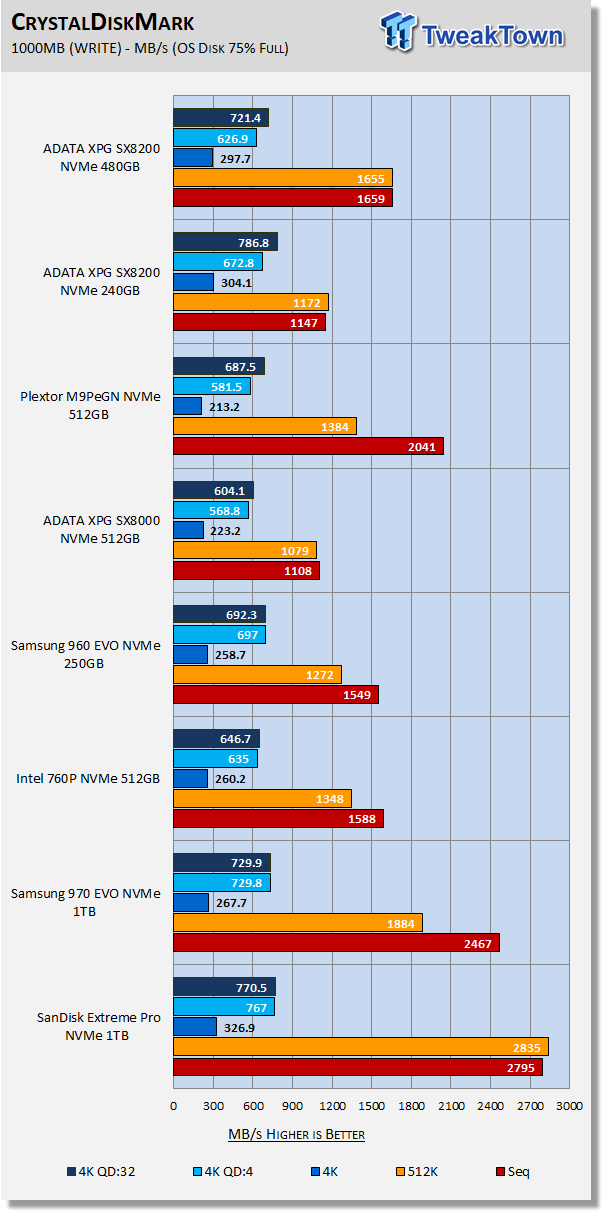
Random write performance at QD1 is exceptionally good. The only SSD in our test pool than can best the SX8200 is SanDisk's Extreme Pro.
AS SSD
Version and / or Patch Used: 1.8.5611.39791
AS SSD determines the performance of SSDs. The tool contains four synthetic as well as three practice tests. The synthetic tests are to determine the sequential and random read and write performance of the SSD. We evaluate AS SSD performance in terms of overall score. We are looking for a minimum score of 2,000 when evaluating NVMe SSDs
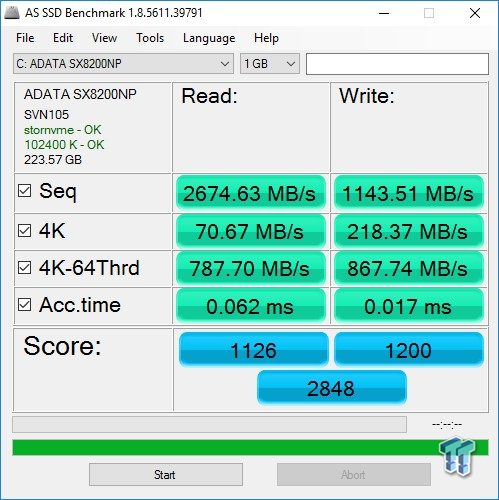
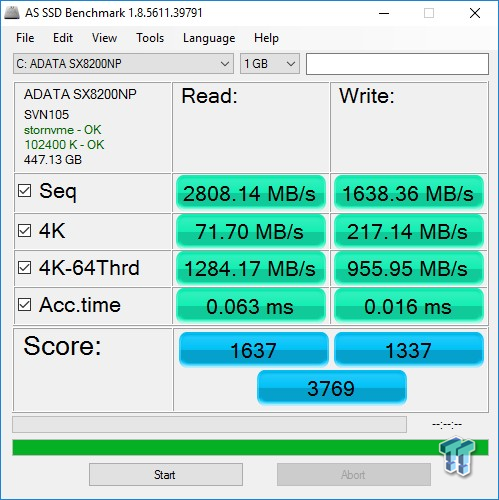

AS SSD is a demanding test, and the SX8200 delivers the goods very well. Samsung's 970 EVO and SanDisk's Extreme Pro both deliver much higher scores. However, don't read too much into that because so much of AS SSD scoring is derived from random performance at QD64, which is completely out of range for consumer SSDs.
Benchmarks (OS) - Vantage, PCMark 7, PCMark 8 & More
Moderate Workload Model
We categorize these tests as indicative of a moderate workload environment.
PCMark Vantage - Hard Disk Tests
Version and / or Patch Used: 1.2.0.0
The reason we like PCMark Vantage is because the recorded traces are played back without system stops. What we see is the raw performance of the drive. This allows us to see a marked difference between scoring that other trace-based benchmarks do not exhibit. An example of a marked difference in scoring on the same drive would be empty vs. filled vs. steady state.
We run Vantage three ways. The first run is with the OS drive 75% full to simulate a lightly used OS volume filled with data to an amount we feel is common for most users. The second run is with the OS volume written into a "Steady State" utilizing SNIA's consumer guidelines. Steady state testing simulates a drive's performance similar to that of a drive that been subjected to consumer workloads for extensive amounts of time. The third run is a Vantage HDD test with the test drive attached as an empty, lightly used secondary device.
OS Volume 75% Full - Lightly Used
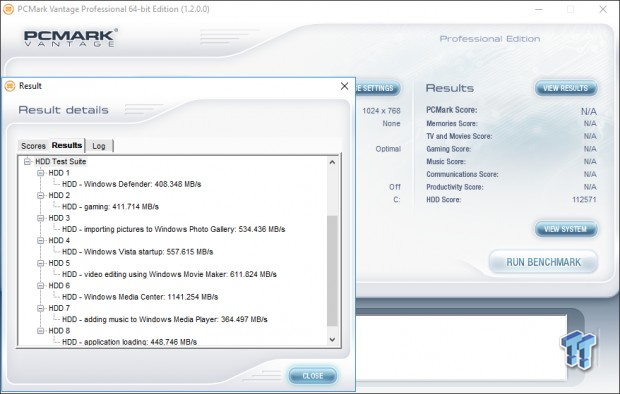
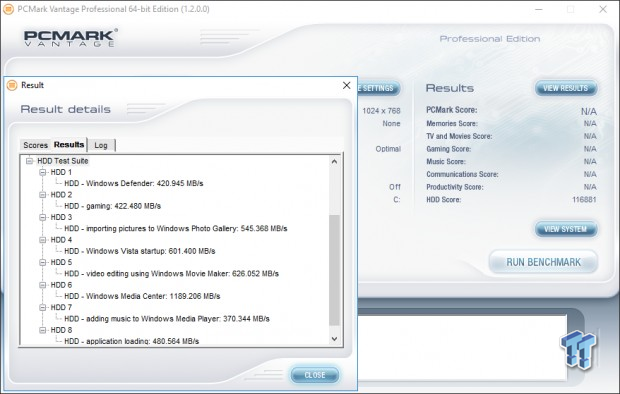
OS Volume 75% Full - Steady State
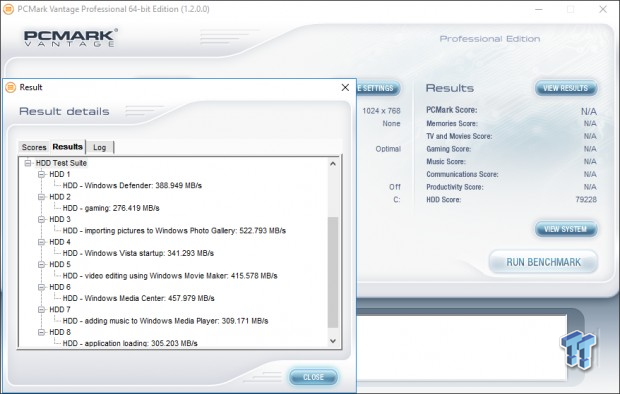
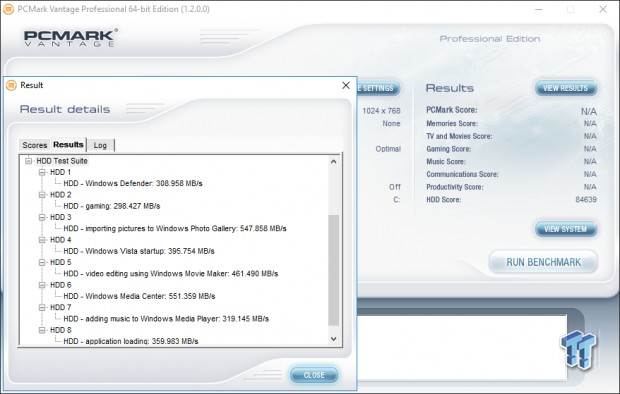
Secondary Volume Empty - FOB
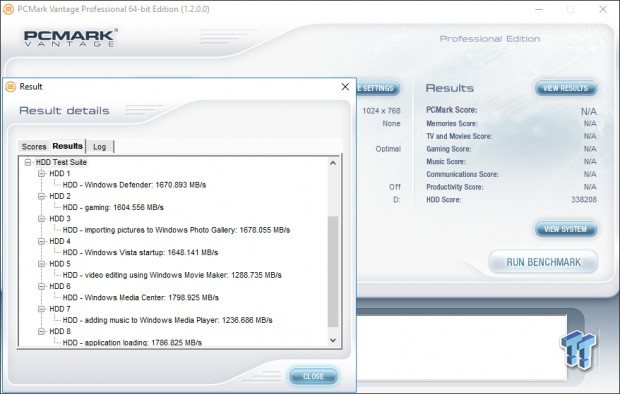
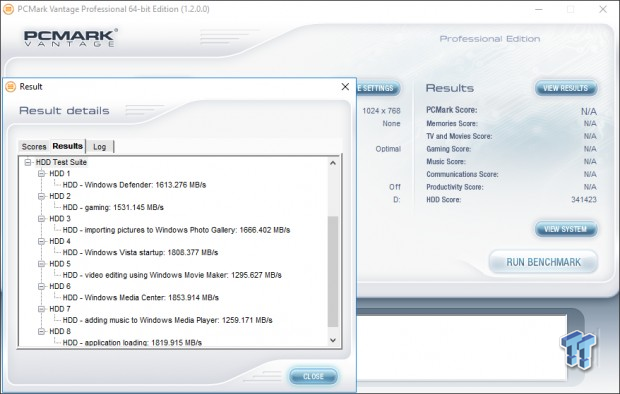
There's a big difference between an empty drive, one that's 75% full/used, and one that's in a steady state.
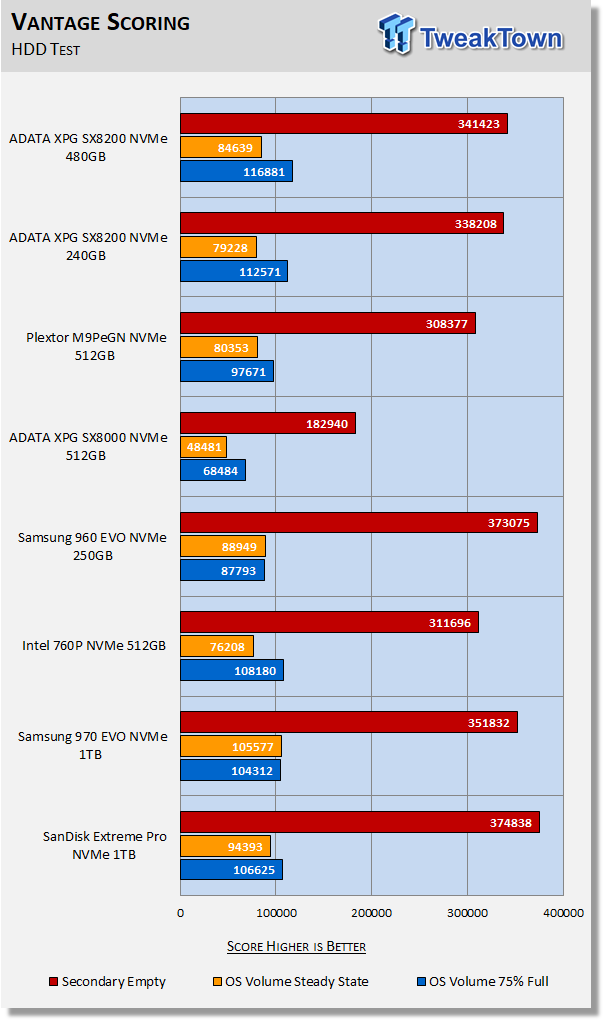
The important scores to pay attention to are "OS Volume Steady State" and "OS Volume 75% full." These two categories are most important because they are indicative of typical of consumer user states. When a drive is in a steady state, it means garbage collection is running at the same time it's reading/writing.
Focusing in on 75% full, which would be the most typical user state for most users, the SX8200 sets new lab records for a TLC-based SSD. In a steady state, the SX8200 does take a bit of a beating, falling to the middle of the pack. The good news is that steady-state performance is rarely a consideration in the consumer space.
PCMark 7 - System Storage
Version and / or Patch Used: 1.4.0
We will look to Raw System Storage scoring for evaluation because it's done without system stops and, therefore, allows us to see significant scoring differences between drives. When evaluating NVMe SSDs we are looking for a minimum score of 11,000
OS Volume 75% Full - Lightly Used
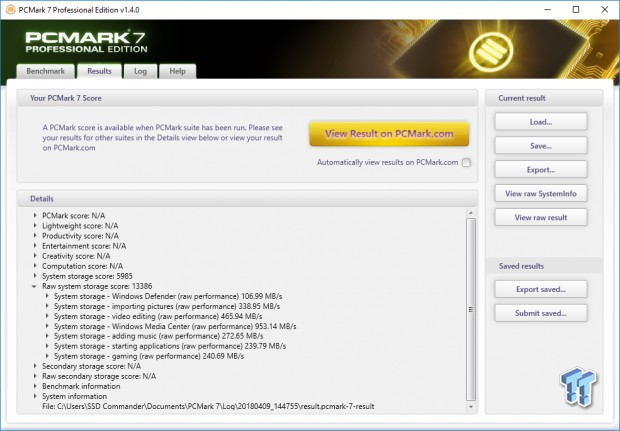
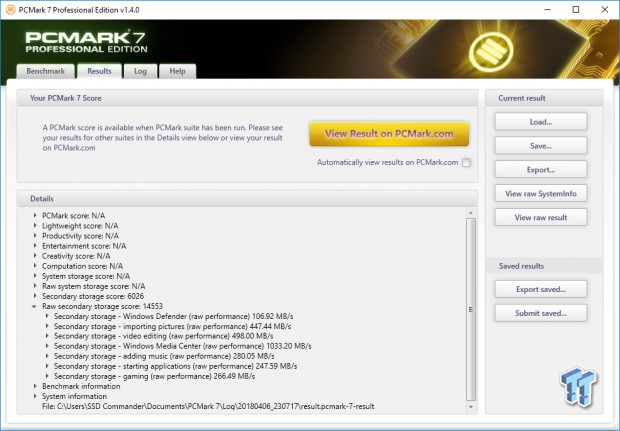
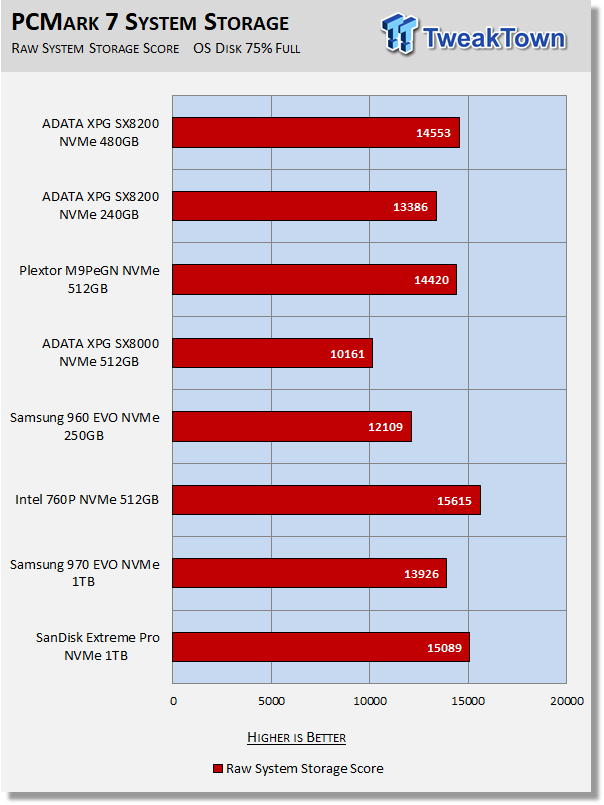
Up to this point, the SX8200 has shown itself to be considerably faster then Intel's 760P. However, this time the 760P delivers considerably better performance. For reasons unknown, the SX8200 does not like this particular test when data is on the drive. If you look at our maxed-out-performance page you will see that the SX8200 scores an amazing 18K when empty.
PCMark 8
Version and / or Patch Used: 2.4.304
We use PCMark 8 Storage benchmark to test the performance of SSDs with traces recorded from Adobe Creative Suite, Microsoft Office, and a selection of popular games. You can test the system drive or any other recognized storage device, including local external drives.
Unlike synthetic storage tests, the PCMark 8 Storage benchmark highlights real-world performance differences between storage devices. We focus on the total score first and then storage bandwidth when evaluating PCMark 8 results.
OS Volume 75% Full - Lightly Used
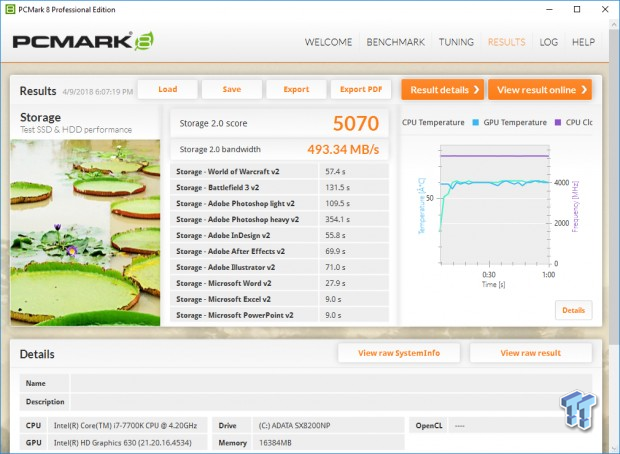
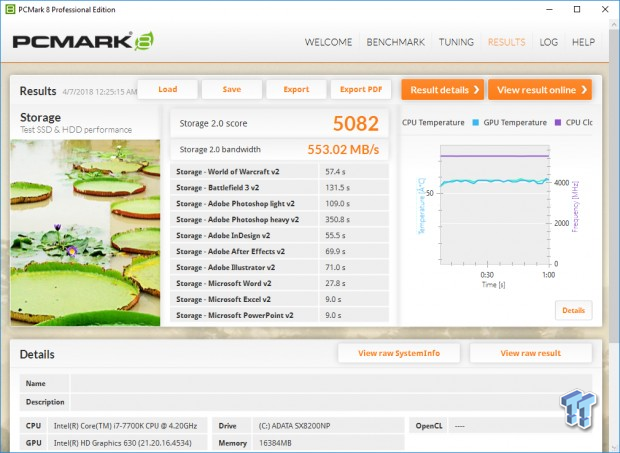

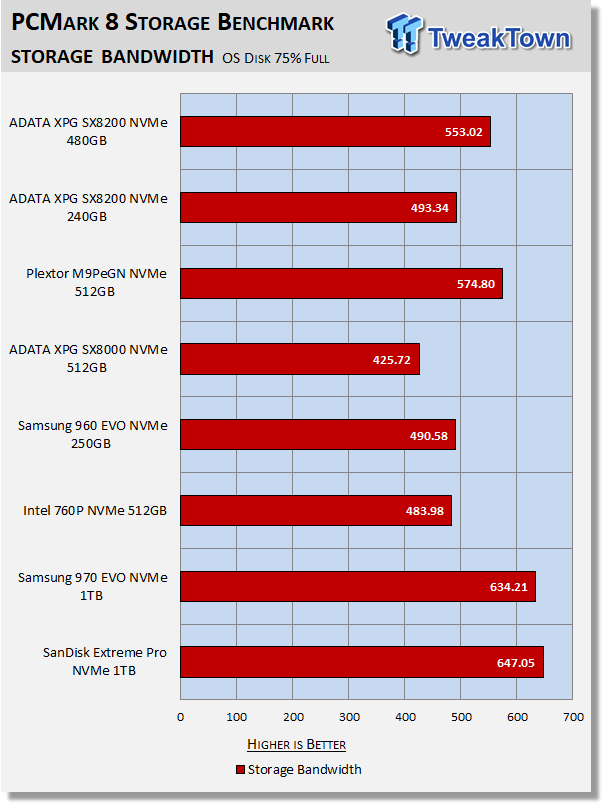
PCMark 8 is the most intensive moderate workload simulation we run. This is where we see a real disadvantage for smaller capacity SSDs. This capacity disadvantage is why the 1TB 970 EVO and 1TB Extreme Pro are outperforming the 240 and 480GB SX8200. We believe that if we had the 960GB SX8200 in the lab it would deliver a storage bandwidth of over 800MB/s. We have seen a similarly configured HP EX920 1TB SSD do it.
BAPCo SYSmark 2014 SE Application Performance
Version and / or Patch Used: 2.0.0.70
SYSmark 2014 SE is considered the gold standard for testing system performance because it is an application based benchmark. This test gives us the ultimate in real-world results because it utilizes actual applications running on the system, instead of playing back recorded traces. If you want to know what kind of impact a particular SSD will have on your system's overall performance; this test will show you.
Our systems are much more powerful than the calibration system (1000-point baseline) used by BAPCo, so we ran an OCZ TL100 120GB SATA III SSD to establish a comparison point relative to our test systems. We will be running this test going forward and we will add drives to our chart as we test them.
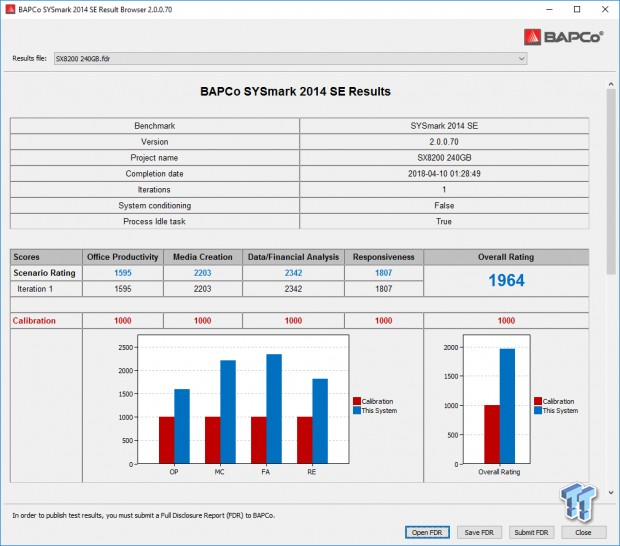
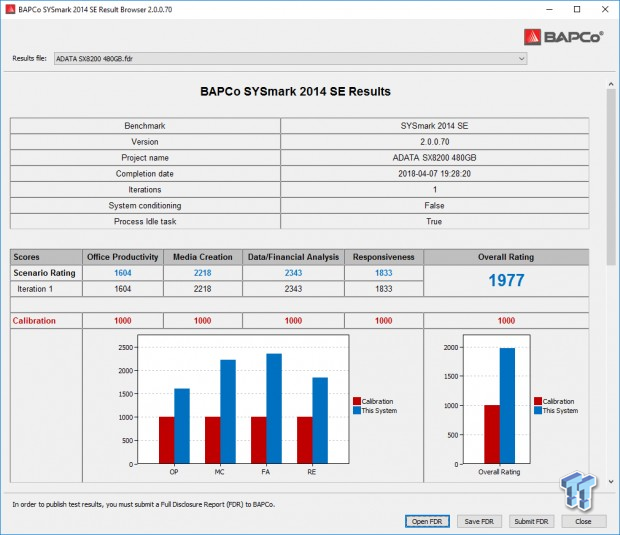
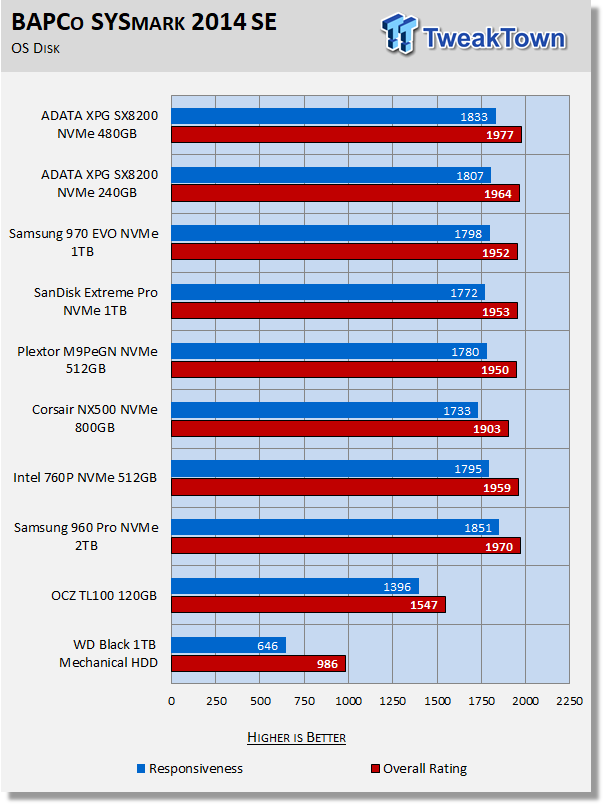
Capacity is much less of an advantage with SYSmark. A few points are a big deal when comparing SYSmark results. Look at the SX8200, it is smashing all the TLC-based competition. The only SSD on our chart that can beat the SX8200 in responsiveness is the $1000 MLC powered 960 Pro 2TB. Even then, the 480GB SX8200 beats it in total score.
This is the real deal, this is what matters most - actual application performance. These results are one of several reasons why we believe IMFT 64-layer TLC flash is currently the best there is. As we see it, it's worst to first for ADATA, SMI and Micron.
Benchmarks (Secondary) - IOPS, Response & Transfer Rate
Iometer - Maximum IOPS
Version and / or Patch Used: Iometer 2014
We use Iometer to measure high queue depth performance. (No Partition)
Max IOPS Read
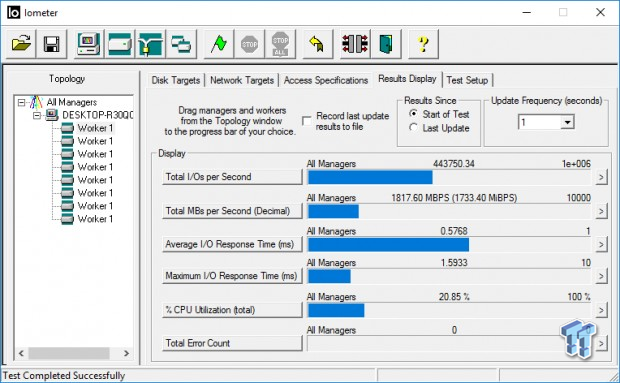
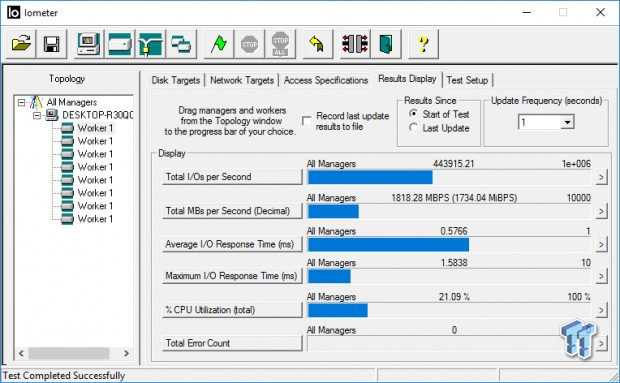
Max IOPS Write
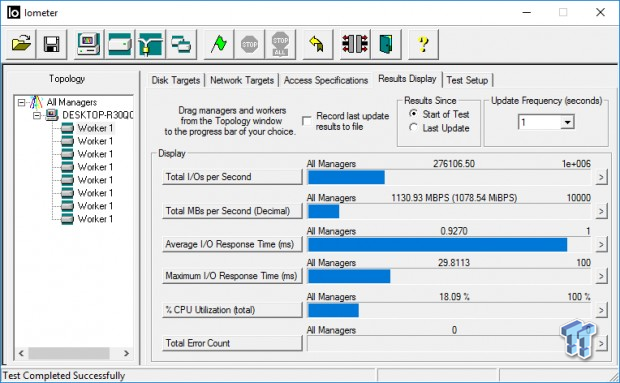
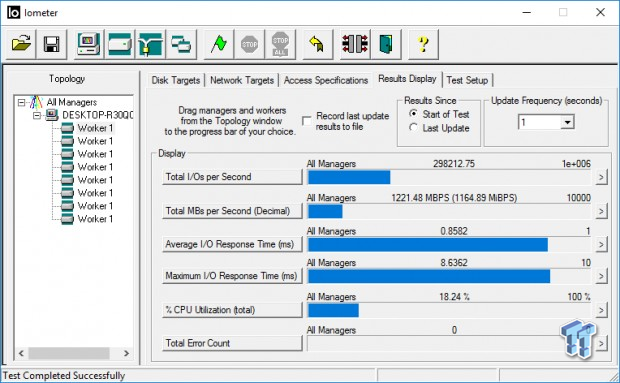
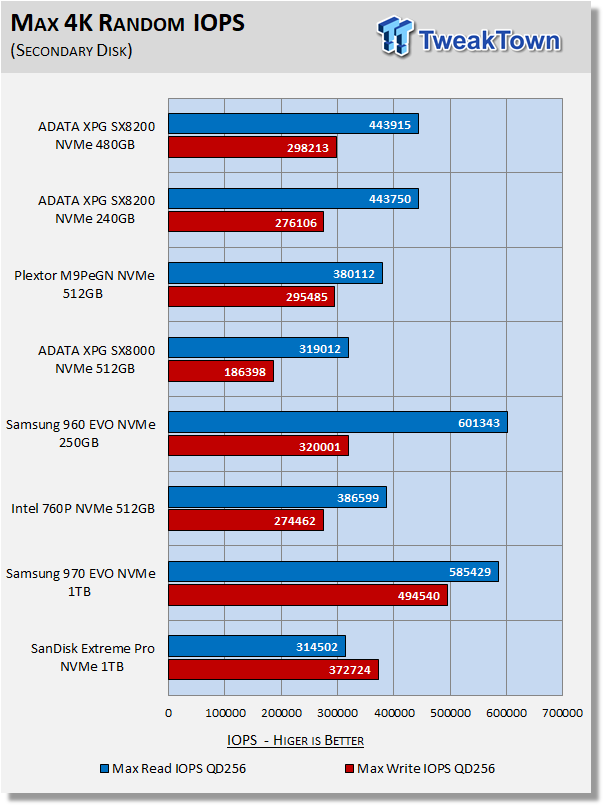
We test NVMe SSDs using eight threads at QD32, or QD256. We do this because we want to see what the drive can generate at its maximum attainable queue depth. We have no problem exceeding factory max random IOPS specs.
Iometer - Disk Response
Version and / or Patch Used: Iometer 2014
We use Iometer to measure disk response times. Disk response times are measured at an industry accepted standard of 4K QD1 for both write and read. Each test runs twice for 30 seconds consecutively, with a 5-second ramp-up before each test. We partition the drive/array as a secondary device for this testing.
Avg. Write Response
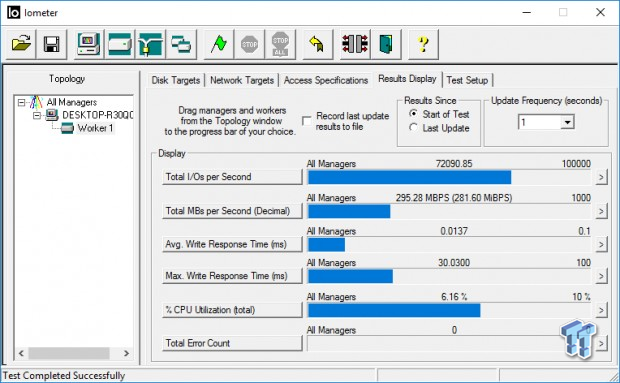
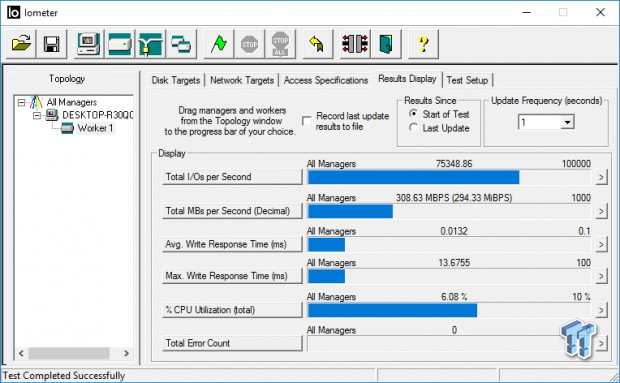
Avg. Read Response
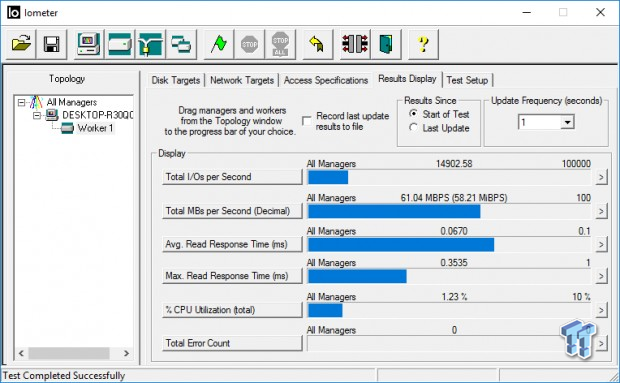
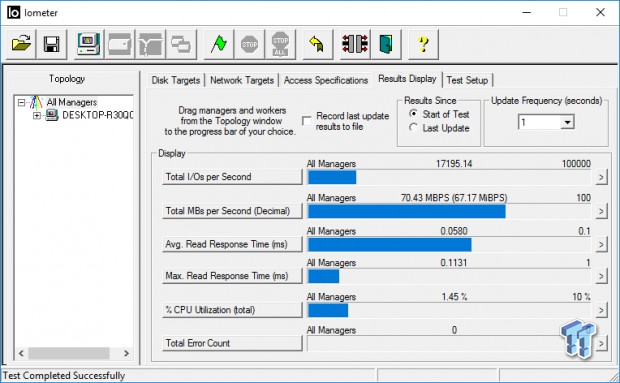

More lab records for TLC-based SSDs are served up by the SX8200. The SX8200 delivers by-far the best random read response at QD1 for a TLC-based SSD. Where it really matters, is where the SX8200 really delivers. This is another demonstration of why we like IMFT 64-layer flash so much.
DiskBench - Transfer Rate
Version and / or Patch Used: 2.6.2.0
We use DiskBench to time a 28.6GB block (9,882 files in 1,247 folders) composed primarily of incompressible sequential and random data as it's transferred from our Toshiba RD400 1TB NVME SSD to our test drive. We then read from a 6GB zip file that's part of our 28.6GB data block to determine the test drive's read transfer rate. Our system is restarted prior to the read test to clear any cached data, ensuring an accurate test result.
Write Transfer Rate

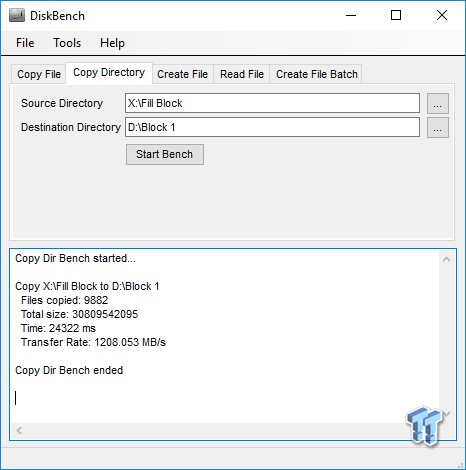
Read Transfer Rate



Here again, we see that ADATA's recipe is a bit better than Intel's. The 480GB SX8200 delivers more than double the sustained write performance of the 760P. Intel's 760P employs a fixed SLC buffer capacity. ADATA's SX8200 employs a dynamic SLC buffer that can expand its capacity into unused space. This is why the SX8200's write transfer rate is more than double the 760P.
Benchmarks - Mixed Workload & Sustained Sequential Write
70/30 Mixed Workload Test (Sledgehammer)
Version and / or Patch Used: Iometer 2014
Heavy Workload Model
This test hammers a drive so hard we've dubbed it "Sledgehammer". Our 70/30 Mixed Workload test is designed to simulate a heavy-duty enthusiast/workstation steady-state environment. We feel that a mix of 70% read/30% write, full random 4K transfers best represents this type of user environment. Our test allows us to see the drive enter into and reach a steady state as the test progresses.
Phase one of the test preconditions the drive for 1 hour with 128K sequential writes at QD32. Phase two of the test runs a 70% read/30% write at QD32, full random 4K transfer workload on the drive for 1 hour. We log and chart (phase two) IOPS data at 5-second intervals for 1 hour (720 data points). 60 data points = 5 minutes.
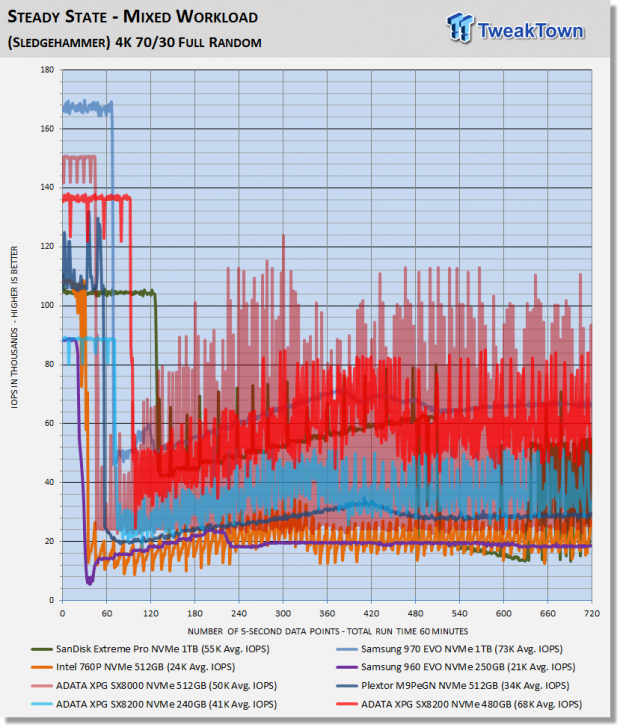
What we like about this test is that it reflects reality. Everything lines up, as it should. Consumer drives don't outperform Enterprise-Class SSDs that were designed for enterprise workloads. Consumer drives based on old technology are not outperforming modern Performance-Class SSDs, etc.
The SX8200 handles this brutal test surprisingly well. The 480GB model is second only to the 970 EVO, but we again believe that this is due to a huge capacity advantage. We believe that a 960GB SX8200 would easily beat the 1TB 970 EVO. We also like that SMI has tightened the variability significantly in comparison to the SM2260 powered SX8000. We would still like to see a tighter pattern, but the average is outstanding.
Sustained Sequential Write
Version and / or Patch Used: Iometer 2014
Heavy Workload Model
We write to the drive for 1 hour with 128K sequential writes at QD32. We log and chart megabytes per second data at 5-second intervals for 1 hour (720 data points). 60 data points = 5 minutes.
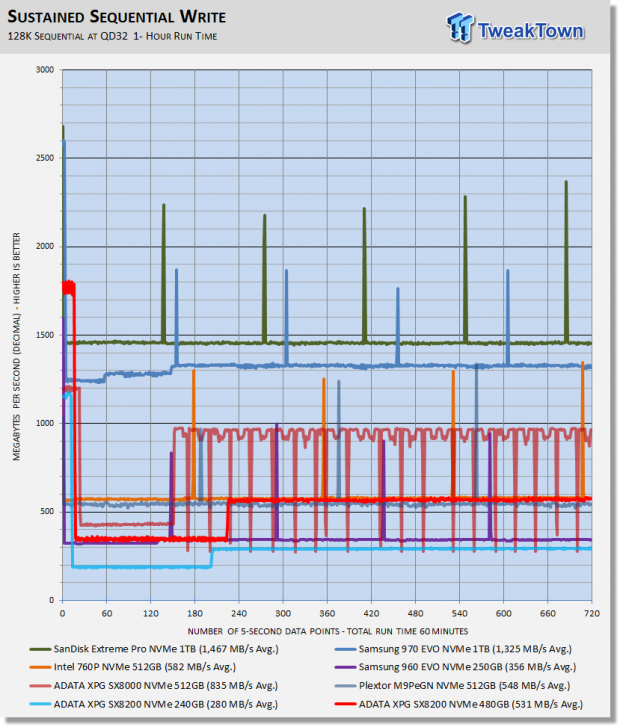
This test unmasks the sequential write performance of TLC flash arrays. The SX8200 is bringing up the rear at its respective capacity points. However, we will not hold this against the drive because it did very well with our transfer test, and because sustained sequential writes of this nature are practically non-existent in the consumer space. We only run this test to unmask a TLC drives native sequential write performance.
Maxed-Out Performance (MOP)
This testing is just to see what the drive is capable of in a FOB (Fresh Out of Box) state under optimal conditions. We are utilizing empty volumes of Windows 10 and Windows Server 2008 R2 64-bit for this testing.
Windows 10 MOP
ADATA SX8200 240GB M.2 PCIe NVMe SSD

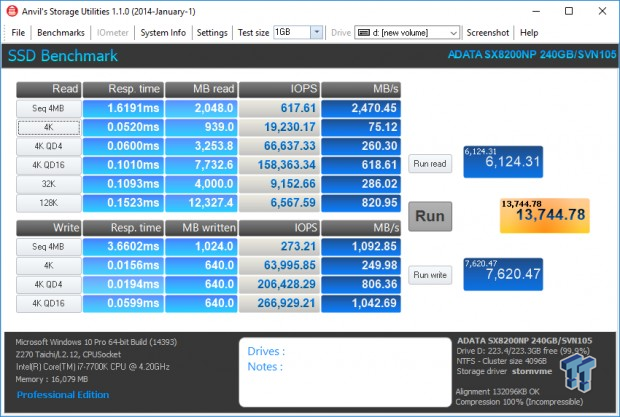
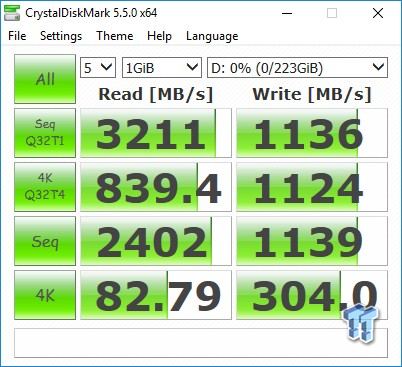

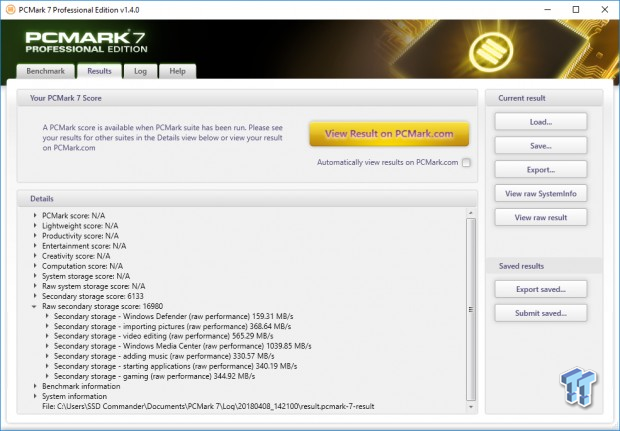
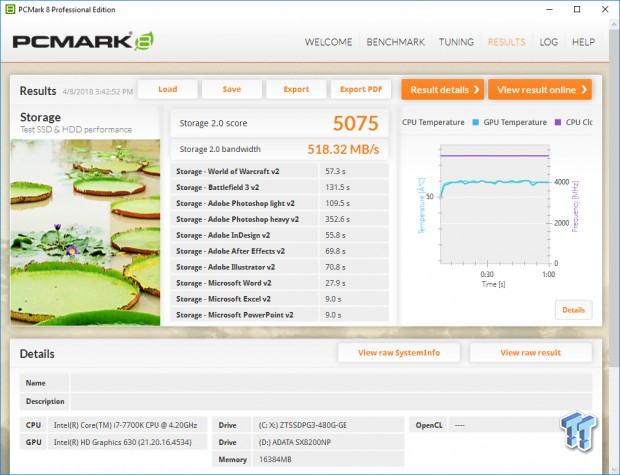
Windows Server 2008 R2 MOP
ADATA SX8200 240GB M.2 PCIe NVMe SSD
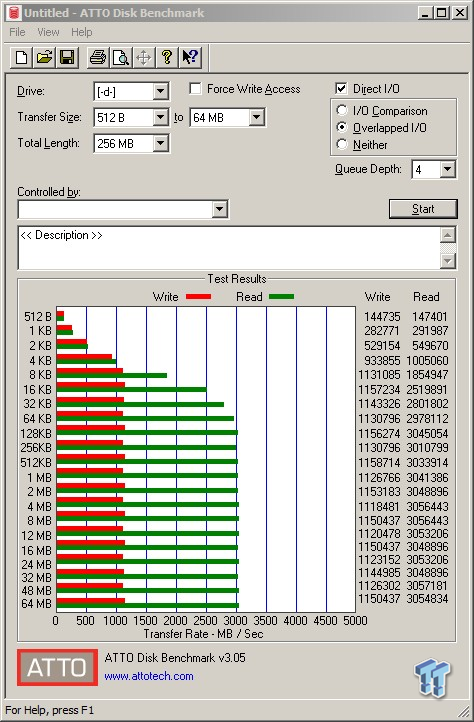
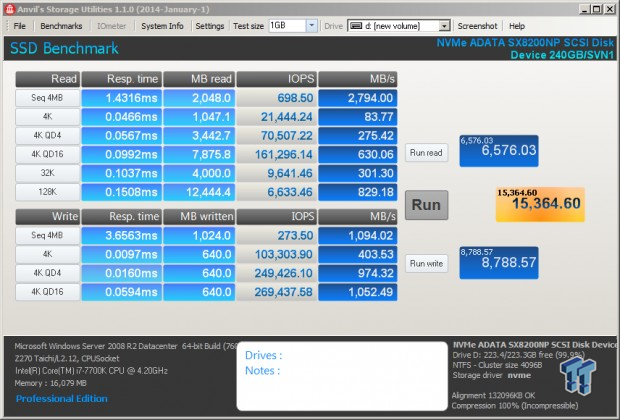

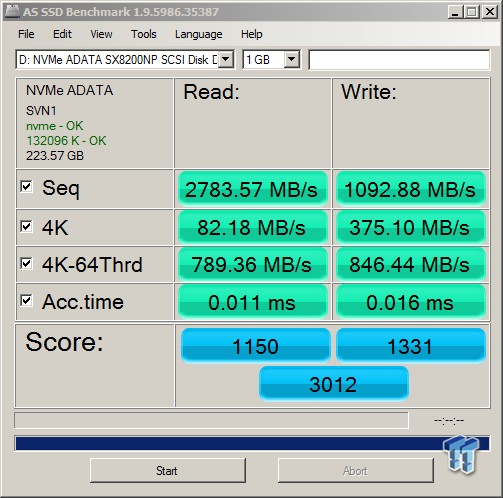
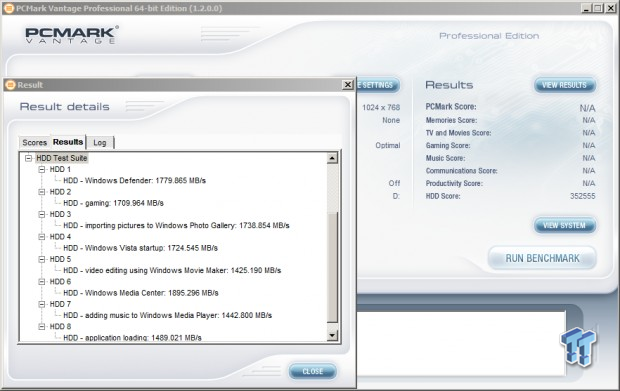
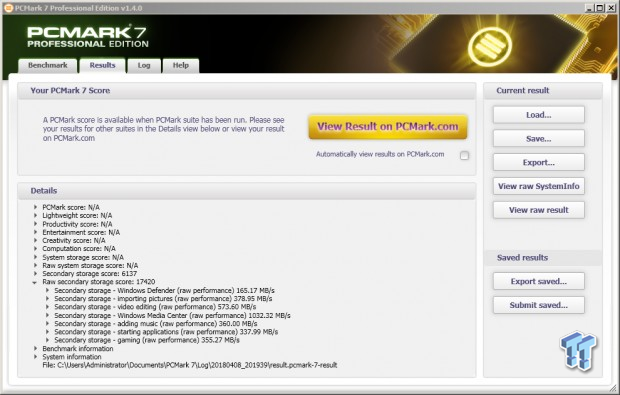
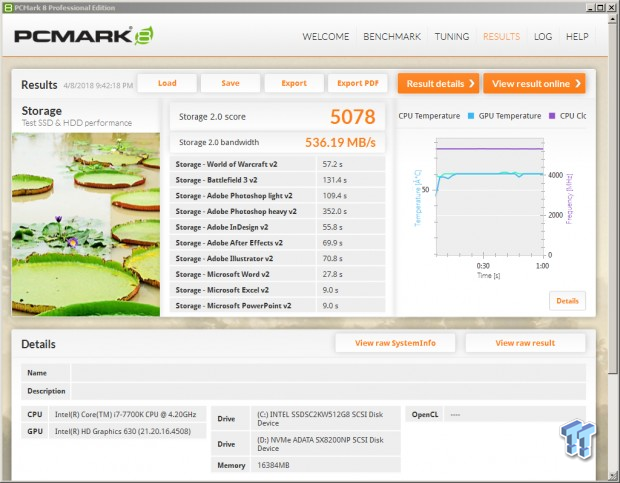
Windows 10 MOP
ADATA SX8200 480GB M.2 PCIe NVMe SSD

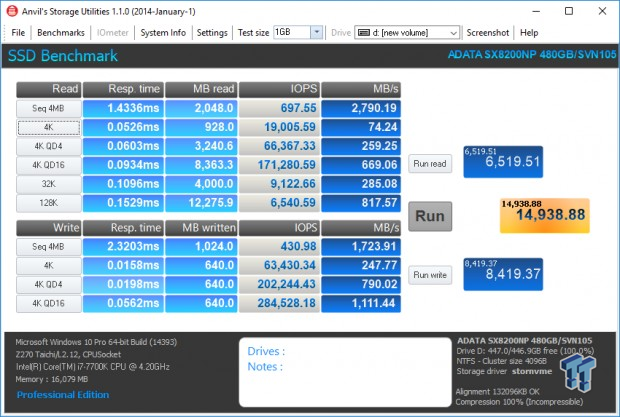

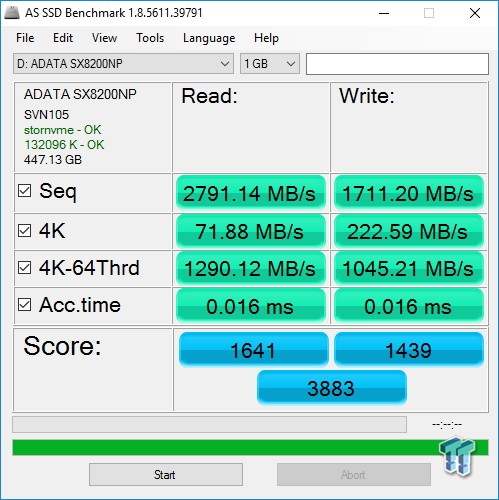
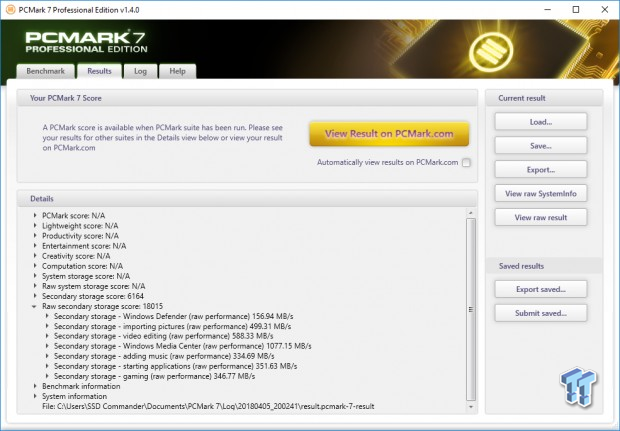
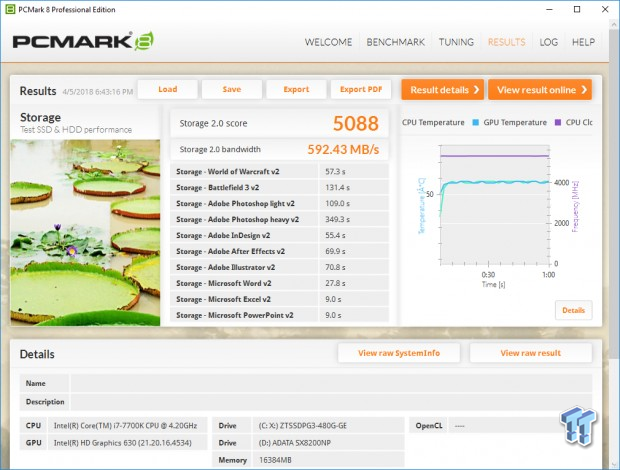
Windows Server 2008 R2 MOP
ADATA SX8200 480GB M.2 PCIe NVMe SSD

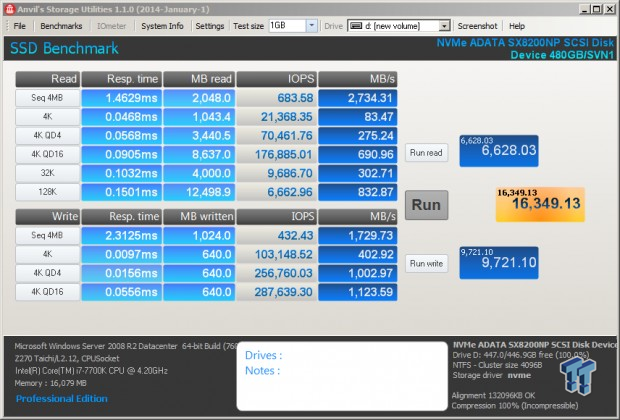

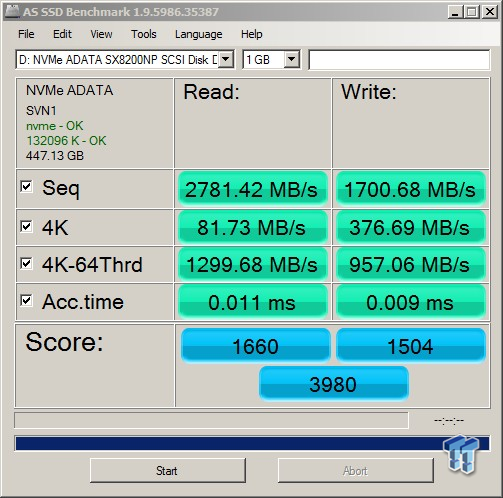
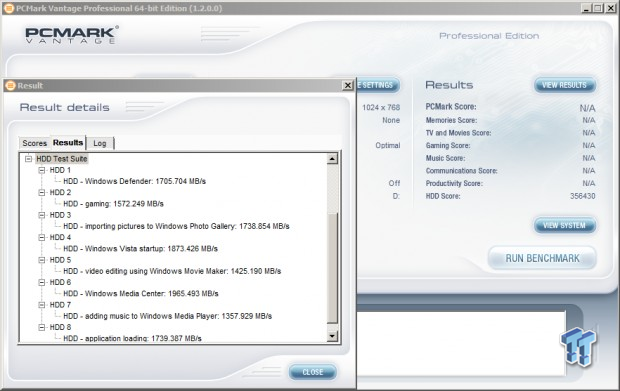
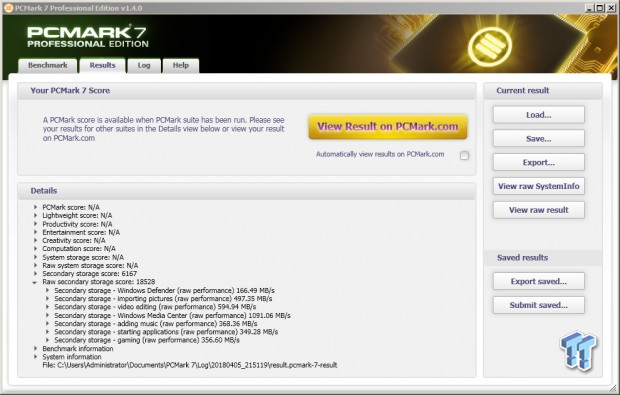
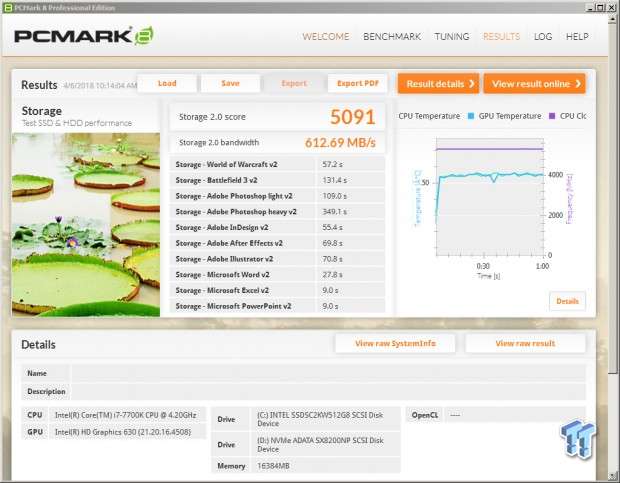
Final Thoughts
ADATA's SX8200 rights all the wrongs of its predecessor the SX8000. Going from worst to first isn't something you see every day. It has been a long time, maybe this is even the first time we have felt that what ADATA is serving up on the storage front is better than the competition.
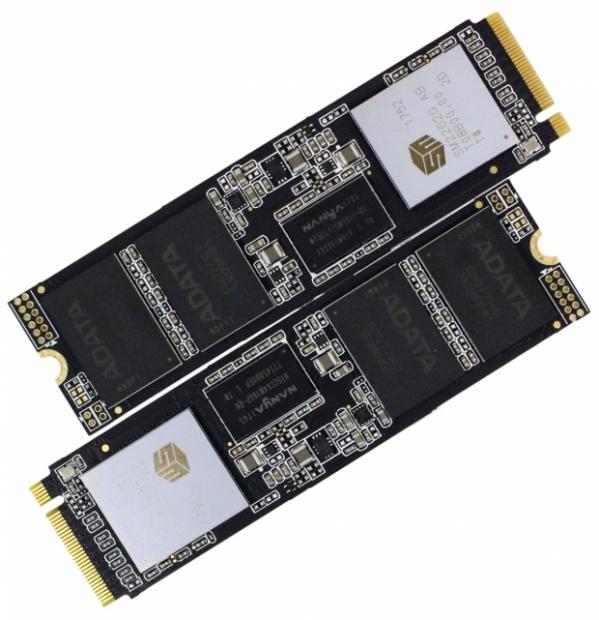
As we see it, ADATA's SX8200 is proof that someone is paying attention to performance that actually matters. The same argument we use for Optane applies to the SX8200. It's all about low queue-depth random read performance. After all, in a typical consumer use case scenario, your computer is reading random data 70-80% of the time you are using it. 95% of the random data read occurs at queue depths below four, making random read performance at low QD by far the most important performance metric.
Our synthetic testing, most notably our response testing, clearly shows that the SX8200 is in a league of its own when reading random data at QD1. It's not only far better than any TLC we've tested, it's also better than any MLC SSD we've tested. We attribute this performance mainly to Micron's stellar 64-Layer TLC flash. Silicon Motion's SM2262 is also a big factor as is ADATA's choice of configuration and firmware expertise.
Throughout our testing, ADATA's SX8200 delivered the best low queue-depth random read performance for a consumer flash-based SSD we've seen to date. Looking back at our charts, we are most impressed with how the SX8200 dominated our SYSmark testing. Despite its capacity handicap, the SX8200 absolutely crushed Samsung's 1TB 970 EVO and SanDisk's 1TB Extreme Pro when running actual applications. Performance, where it matters, is performance that is tangible to the end-user.
Performance where it matters is what we are looking for more than anything else. Right behind that is of course pricing and warranty. And finally, we like to see management and cloning software included for free. ADATA gives us everything we are looking for in the SX8200. Best performance for flash where it matters. Low pricing, 5-year warranty, high endurance and a nice software bundle that is available for free via download.

If user experience could be shown in by just one number, it would be the number highlighted above. In terms of overall performance when running moderate workloads, you can expect the SX8200 to deliver moderate workload performance that is as good as it gets for flash. The user experience delivered by an SSD this fast is incredible. The SX8200 boots as fast or faster than any flash-based SSD we've tested to date, multitasks with ease, and never lags no matter what you throw at it. A true Tier-1 SSD experience.
We are pleasantly surprised by the total package that is the SX8200. Like we stated earlier, it is our new lab favorite. ADATA's SX8200 is TweakTown recommended and Editors Choice awarded.
Pros:
- Low QD Random Read
- Application Performance
- Included Software
- Pricing
- 5-year Warranty
Cons:
- No Proprietary Driver

| Performance | 99% |
| Quality | 100% |
| Features | 100% |
| Value | 98% |
| Overall | 99% |
The Bottom Line: Performance where it matters is what the SX8200 delivers.
PRICING: You can find products similar to this one for sale below.
 United
States: Find other tech and computer products like this
over at Amazon.com
United
States: Find other tech and computer products like this
over at Amazon.com
 United
Kingdom: Find other tech and computer products like this
over at Amazon.co.uk
United
Kingdom: Find other tech and computer products like this
over at Amazon.co.uk
 Australia:
Find other tech and computer products like this over at Amazon.com.au
Australia:
Find other tech and computer products like this over at Amazon.com.au
 Canada:
Find other tech and computer products like this over at Amazon.ca
Canada:
Find other tech and computer products like this over at Amazon.ca
 Deutschland:
Finde andere Technik- und Computerprodukte wie dieses auf Amazon.de
Deutschland:
Finde andere Technik- und Computerprodukte wie dieses auf Amazon.de
What's in Jon's PC?
- CPU: AMD Ryzen 7800X 3D
- MOTHERBOARD: GIGABYTE AORUS Master X670E
- RAM: Kingston Fury Renegade 7200MHz 32GB
- GPU: ZOTAC AMP Extreme GeForce RTX 4090
- SSD: Crucial T700 2TB Gen5
- OS: Windows 11 Pro
- COOLER: Lian Li Galahad 360 AIO
- CASE: Lian Li Lancool III
- KEYBOARD: Corsair K65 RGB Mini
- MOUSE: SteelSeries AEROX 5 Wireless
- MONITOR: ASUS ROG Strix PG27AQN 360Hz 1440p ULMB2
Similar Content
Related Tags

